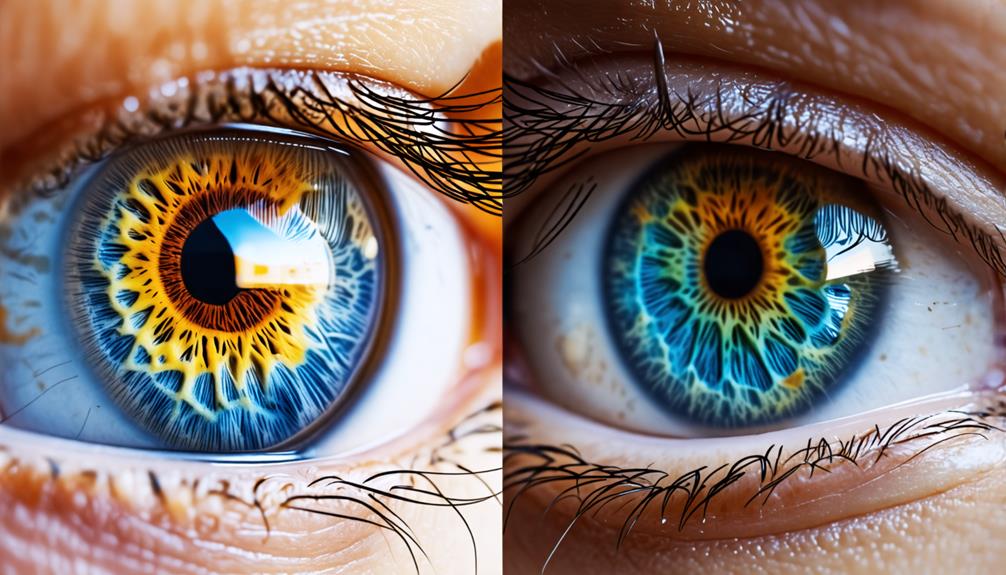You've probably noticed how enchanting someone's eyes can be, but have you ever considered that no two people share exactly the same eye color? It's true—even among those with seemingly identical hues. This fascinating fact stems from the intricate interplay of genetics and physical structures within the iris. While you might classify eye colors into broad categories like blue, green, or brown, the reality is far more complex. Each person's eyes tell a unique story, one that's as individual as their fingerprints. But what causes this remarkable variation, and how does it impact our perceptions of beauty and identity?
Key Takeaways
- Iris structures are unique like fingerprints, ensuring no two people have identical eye colors.
- Over 16 genes contribute to eye color, creating innumerable combinations of shades and patterns.
- Melanin production in the iris varies, producing a wide spectrum of colors from blue to brown.
- Genetic factors account for about 75% of eye color variation, allowing for significant individual differences.
The Science of Eye Color

Delving into the science of eye color reveals a fascinating interplay between genetics and evolution, with a handful of genes orchestrating the diverse spectrum of hues we see in human irises.
Your eye color is primarily determined by the OCA2 gene and its partner HERC2, which regulate melanin production in the iris. This pigment is responsible for the range of colors from blue to brown. Genetic factors account for about 75% of eye color variation, with over 16 genes contributing to specific shades and patterns.
You might be surprised to learn that blue eyes are a relatively recent evolutionary trait, arising from a genetic mutation that reduces melanin.
Each person's iris has a unique structure, much like a fingerprint. In rare cases, you may encounter heterochromia, where someone has two different colored eyes due to genetic factors or other influences.
Genetic Factors and Variations
Countless genetic factors interplay to create the unique tapestry of eye colors you see in the world around you. The OCA2 and HERC2 genes play a primary role in determining eye color by influencing melanin levels in the iris. While OCA2 accounts for about 75% of eye color variation, over 16 genes contribute to the wide range of possible combinations.
You'll find that no two people, even identical twins, have exactly the same eye color or iris pattern. This complexity rivals that of snowflakes and fingerprints. While blue eyes are often considered unique, green eyes are actually the rarest, occurring in only 2% of the global population.
| Gene | Function |
|---|---|
| OCA2 | Melanin production |
| HERC2 | OCA2 regulation |
| SLC24A4 | Calcium transport |
| TYR | Melanin synthesis |
| TYRP1 | Melanin stabilization |
Cultural Impact of Unique Eyes

Unique eye colors and patterns have captivated cultures worldwide, shaping perceptions of beauty, identity, and even personality traits.
You'll find that different societies attribute varying meanings to eye colors, with Western cultures often valuing blue eyes, while some Asian cultures prefer darker hues. The rarity of green and gray eyes contributes to their cultural significance, influencing perceptions of attractiveness and uniqueness.
Heterochromia, a condition where eyes have different colors, often attracts attention and can enhance personal identity.
Media representations and artistic portrayals frequently celebrate individuals with distinctive eye characteristics, impacting social dynamics.
You'll notice that throughout history, unique eye colors have symbolized mystery and allure in literature and art, reflecting societal values.
These cultural narratives surrounding eye color variations continue to shape how you perceive and interact with others, highlighting the enduring fascination with the diversity of human eyes.
Conclusion
You've learned that your eyes are as unique as your fingerprints. It's fascinating to think you'll never meet someone with exactly the same eye color as you.
This genetic marvel isn't just about science; it's part of what makes you special.
Next time you look in the mirror, take a moment to appreciate the intricate beauty of your irises. They're telling a story that's uniquely yours.

Leave a Reply